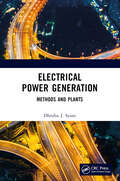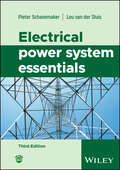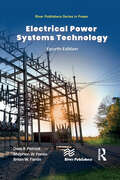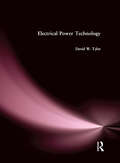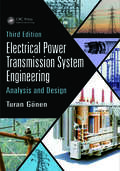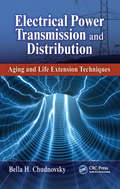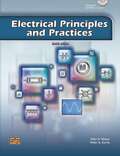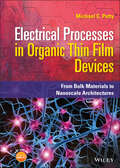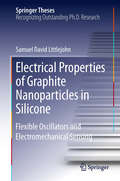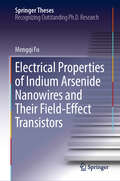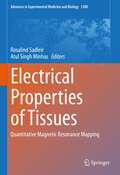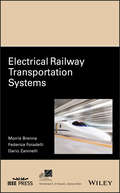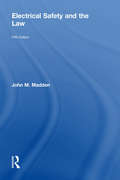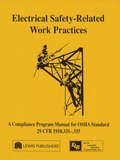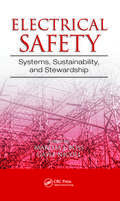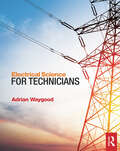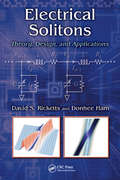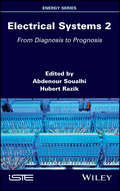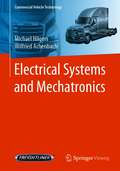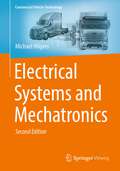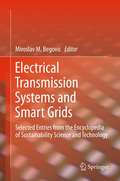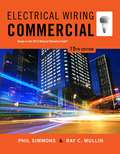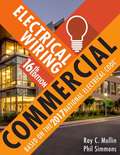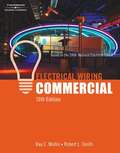- Table View
- List View
Electrical Power Generation: Methods and Plants
by Dhruba J. SyamIn today’s world, per capita consumption of electricity in a country is considered as one of the important indices of its developmental status: both economic and technological. Engineering students as well as the professional beginners, studying and working in the field of Electrical Power Generation and Power Plant Administration, should get a reasonable level of familiarization with the concepts of various technological methods and plants in order to acquire necessary knowledge and competency for a worthwhile professional career in the subject field. This book attempts to provide relevant knowledge inputs by way of providing conceptual clarity on various aspects of the subject. It will be helpful for students of Electrical and Mechanical Engineering. Print edition not for sale in South Asia (India, Sri Lanka, Nepal, Bangladesh, Pakistan and Bhutan)
Electrical Power System Essentials
by Pieter Schavemaker Lou van der SluisA highly accessible resource covering the basics of the design and operation of electrical power systems with minimal technical background required Electrical Power System Essentials delivers a thorough introduction to the electrical power system and its functioning, and the changes that come with the worldwide energy transition process. This revised and updated Third Edition includes new material on HVDC developments, electricity markets, capacity calculation (NTC and flow-based), power system protection, and energy storage. Discussions on how renewable sources play a more dominant role in the generation of electrical energy and the effects they have on the control and operation of the grid and electricity markets are also included. Written in the accessible style that has made previous editions so popular with readers, this book restricts math content to the Appendix in order to maintain an easy reading experience of the main text while still providing complete coverage. A companion website includes downloadable teaching materials, and accessory videos are viewable on the Wiley website (www.wiley.com/go/powersystem3e) and YouTube (https://www.youtube.com/playlist?list=PLvaU1SY38TUV8JTwkf1taN-w_bQbCD0Ad). Topics discussed in the book include: Generation of electric energy, covering nuclear fission, wind energy and wind turbine concepts, hydropower and pumped storage, and solar powerElectricity markets, covering gas scarcity, its influence on the marginal price of electricity, and negative energy pricesFuture power systems, covering higher harmonics, increased use of cables instead of overhead transmission lines, distributed generation and power-electronic interfacesTransmission of electric energy, covering DC circuit breakers, wide area measurement systems, and distribution networks Electrical Power System Essentials is a perfect textbook for second- and third-year undergraduate electrical engineering students who need an accessible course text introducing concepts in power system engineering. The text is also valuable for other students and professionals who require an up-to-date reference on power systems technology.
Electrical Power Systems Technology
by Stephen W. Fardo Dale R. Patrick Brian W. FardoElectrical Power Systems Technology, Fourth Edition covers a wide range of technologies and systems used in the generation, distribution, control, conversion, and measurement of electrical power. This reference book provides a foundational overview presented in a basic, easy-to-understand manner. The content is organized in a logical pedagogical style using five basic power system components – Measurement, Generation, Distribution, Control, and Conversion. Each of these basic systems is broken down into sub-systems, equipment, and components that are explored in greater detail in each of the 18 chapters. Simplified mathematical concepts are described with practical applications to assist in fundamental understanding. Abundant illustrations (almost one per page) are used to add visual information to supplement technical knowledge development. The fourth edition has been edited to provide improved information and clarity, including many new illustrations. An additional chapter – Chapter 18 – Evolving Power System Technologies and Considerations – has been added to describe issues related to power system operation.
Electrical Power Systems Technology, Third Edition
by Stephen W. Fardo Dale R. PatrickCovering the gamut of technologies and systems used in the generation of electrical power, this reference provides an easy-to understand overview of the production, distribution, control, conversion, and measurement of electrical power. The content is presented in an easy to understand style, so that readers can develop a basic comprehensive understanding of the many parts of complex electrical power systems. The authors describe a broad array of essential characteristics of electrical power systems from power production to its conversion to another form of energy. Each system is broken down into sub systems and equipment that are further explored in the chapters of each unit. Simple mathematical presentations are used with practical applications to provide an easier understanding of basic power system operation. Many illustrations are included to facilitate understanding. This new third edition has been edited throughout to assure its content and illustration clarity, and a new chapter covering control devises for power control has been added.
Electrical Power Technology
by D TylerThis book is a comprehensive introductory text on electrical power, encompassing generation, electrical machines, motors, electrical materials, etc. David Tyler's approach is designed for independent or classroom study, with plenty of learning checks and activities throughout. The content is designed to cover Advanced GNVQ and BTEC NII syllabuses, but it is also ideal as an introduction for first year degree students or for professionals seeking to reinforce their grasp of the fundamentals.
Electrical Power Transmission System Engineering: Analysis and Design, Third Edition
by Turan GonenElectrical Power Transmission System Engineering: Analysis and Design is devoted to the exploration and explanation of modern power transmission engineering theory and practice. Designed for senior-level undergraduate and beginning-level graduate students, the book serves as a text for a two-semester course or, by judicious selection, the material
Electrical Power Transmission and Distribution: Aging and Life Extension Techniques
by Bella H. ChudnovskyElectrical distribution and transmission systems are complex combinations of various conductive and insulating materials. When exposed to atmospheric corrosive gases, contaminants, extreme temperatures, vibrations, and other internal and external impacts, these systems deteriorate, and sooner or later their ability to function properly is destroyed. Electrical Power Transmission and Distribution: Aging and Life Extension Techniques offers practical guidance on ways to slow down the aging of these electrical systems, improve their performance, and extend their life. Recognize the Signs of Aging in Equipment—and Learn How to Slow It A reference manual for engineering, maintenance, and training personnel, this book analyzes the factors that cause materials to deteriorate and explains what you can do to reduce the impact of these factors. In one volume, it brings together extensive information previously scattered among manufacturers’ documentation, journal papers, conference proceedings, and general books on plating, lubrication, insulation, and other areas. Shows you how to identify the signs of equipment aging Helps you understand the causes of equipment deterioration Suggests practical techniques for protecting electrical apparatus from deterioration and damage Supplies information that can be used to develop manuals on proper maintenance procedures and choice of materials Provides numerous examples from industry This book combines research and engineering material with maintenance recommendations given in layperson’s terms, making it useful for readers from a range of backgrounds. In particular, it is a valuable resource for personnel responsible for the utilization, operation, and maintenance of electrical transmission and distribution equipment at power plants and industrial facilities.
Electrical Principles and Practices
by Glen MazurThis textbook explains residential, commercial, and industrial applications of electrical and electronic principles. Content includes NFPA 70E® arc blast and arc flash requirements, portable generator sizing, power optimization, utility power factor and peak demand penalty, load shedding, power factor correction, smart grid and smart appliance technology, and wireless speakers.
Electrical Processes in Organic Thin Film Devices: From Bulk Materials to Nanoscale Architectures
by Michael C. PettyElectrical Processes in Organic Thin Film Devices A one-stop examination of fundamental electrical behaviour in organic electronic device architectures In Electrical Processes in Organic Thin Film Devices: From Bulk Materials to Nanoscale Architectures, distinguished researcher Michael C. Petty delivers an in-depth treatment of the electrical behaviour of organic electronic devices focused on first principles. The author describes the fundamental electrical behaviour of various device architectures and offers an introduction to the physical processes that play a role in the electrical conductivity of organic materials. Beginning with band theory, the text moves on to address the effects of thin film device architectures and nanostructures. The book discusses the applications to devices currently in the marketplace, like displays, as well as those under development (transistors, solar cells, and memories). Electrical Processes in Organic Thin Film Devices also describes emerging organic thin film architectures and explores the potential for single molecule electronics and biologically inspired devices. Finally, the book also includes: A detailed introduction to electronic and vibrational states in organic solids, including classical band theory, disordered semiconductors, and lattice vibrations Comprehensive explorations of electrical conductivity, including electronic and ionic processes, carrier drift, diffusion, the Boltzmann Transport Equation, excess carriers, recombination, doping, and superconductivity An overview of important electro-active organic materials, like molecular crystals, charge-transfer complexes, conductive polymers, carbon nanotubes, and graphene Practical considerations of defects and nanoscale phenomena, including transport processes in low-dimensional systems, surfaces and interface states In-depth examinations of metal contacts, including ohmic contacts, the Schottky Barrier, and metal/molecule contacts A systematic guide to the operating principles of metal/insulator/semiconductor structures and the field effect A set of problems (with solutions on-line) for each chapter of the book Perfect for electronics developers and researchers in both industry and academia who study and work with molecular and nanoscale electronics, Electrical Processes in Organic Thin Film Devices also deserves a place in the libraries of undergraduate and postgraduate students in courses on molecular electronics, organic electronics, and plastic electronics.
Electrical Properties of Graphite Nanoparticles in Silicone: Flexible Oscillators and Electromechanical Sensing
by Samuel David LittlejohnThis thesis examines a novel class of flexible electronic material with great potential for use in the construction of stretchable amplifiers and memory elements. Most remarkably the composite material produces spontaneous oscillations that increase in frequency when pressure is applied to it. In this way, the material mimics the excitatory response of pressure-sensing neurons in the human skin. The composites, formed of silicone and graphitic nanoparticles, were prepared in several allotropic forms and functionalized with naphthalene diimide molecules. A systematic study is presented of the negative differential resistance (NDR) region of the current-voltage curves, which is responsible for the material's active properties. This study was conducted as a function of temperature, graphite filling fraction, scaling to reveal the break-up of the samples into electric field domains at the onset of the NDR region, and an electric-field induced metal-insulator transition in graphite nanoparticles. The effect of molecular functionalization on the miscibility threshold and the current-voltage curves is demonstrated. Room-temperature and low-temperature measurements were performed on these composite films under strains using a remote-controlled, custom-made step motor bench.
Electrical Properties of Indium Arsenide Nanowires and Their Field-Effect Transistors (Springer Theses)
by Mengqi FuThis book explores the impacts of important material parameters on the electrical properties of indium arsenide (InAs) nanowires, which offer a promising channel material for low-power electronic devices due to their small bandgap and high electron mobility. Smaller diameter nanowires are needed in order to scale down electronic devices and improve their performance. However, to date the properties of thin InAs nanowires and their sensitivity to various factors were not known. The book presents the first study of ultrathin InAs nanowires with diameters below 10 nm are studied, for the first time, establishing the channel in field-effect transistors (FETs) and the correlation between nanowire diameter and device performance. Moreover, it develops a novel method for directly correlating the atomic-level structure with the properties of individual nanowires and their device performance. Using this method, the electronic properties of InAs nanowires and the performance of the FETs they are used in are found to change with the crystal phases (wurtzite, zinc-blend or a mix phase), the axis direction and the growth method. These findings deepen our understanding of InAs nanowires and provide a potential way to tailor device performance by controlling the relevant parameters of the nanowires and devices.
Electrical Properties of Tissues: Quantitative Magnetic Resonance Mapping (Advances in Experimental Medicine and Biology #1380)
by Rosalind Sadleir Atul Singh MinhasThis book covers the latest developments in tissue electrical conductivity and current density imaging, increasingly popular as well as challenging applications of MRI. These applications are enabled by the acquisition of high-quality MR phase images. This book provides a practical description of the MRI physics needed to understand and acquire phase images in MRI and the key details required to reconstruct them into conductivity, current density or electric field distributions. Comprehensive details are provided about the electrical properties of biological tissues, computational modeling considerations, experimental methods, construction of non-biological and biological phantoms and MRI pulse sequences. An inclusive review of image reconstruction algorithms, and their potential applications is provided for applications directed at determining current density or electric fields, such as in transcranial DC or AC stimulation techniques; as well as electrical conductivity reconstructions that may be of use in quantitative MRI applications used to detect cancer or other pathologies. This is an excellent book for undergraduate and graduate students beginning to explore phase, current density, and conductivity imaging in MRI, and will also be of great use to researchers interested in the area of MR-based electrical property imaging.
Electrical Railway Transportation Systems (IEEE Press Series on Power Engineering)
by Morris Brenna Federica Foiadelli Dario ZaninelliAllows the reader to deepen their understanding of various technologies for both fixed power supply installations of railway systems and for railway rolling stock This book explores the electric railway systems that play a crucial role in the mitigation of congestion and pollution caused by road traffic. It is divided into two parts: the first covering fixed power supply systems, and the second concerning the systems for railway rolling stock. In particular, after a historical introduction to the framework of technological solutions in current use, the authors investigate electrification systems for the power supply of rail vehicles, trams, and subways. Electrical Railway Transportation Systems explores the direct current systems used throughout the world for urban and suburban transport, which are also used in various countries for regional transport. It provides a study of alternating current systems, whether for power supply frequency or for special railway frequency, that are used around the world for the electrification of railway lines, long-distance lines, and high-speed lines. In addition, this resource: Analyzes multiple railway systems from a theoretical and realizable vantage point, with particular regard to functionality, electromagnetic compatibility, and interferences with other electrical systems Studies electric traction railway vehicles, presenting various types of drives and auxiliary devices currently in circulation Discusses solutions employed to ensure interoperability of vehicles that run along lines powered by different systems (e.g., DC and AC, at different frequencies) Electrical Railway Transportation Systems is an ideal text for graduate students studying the subject as well as for industry professionals working in the field.
Electrical Safety and the Law: A Guide To Compliance
by John M MaddenElectrical Safety and the Law describes the hazards and risks from the use of electricity, explaining with the help of case studies and accident statistics the types of accidents that occur and how they can be prevented by the use of safe installations, equipment and working practices. It describes the British legislation on the safety of electrical systems and electrotechnical machinery control systems, much of which stems from European Directives and which will therefore be affected by the UK’s decision to leave the EU (Brexit), and the main standards and guidance that can be used to secure compliance with the law. There are detailed descriptions covering the risks and preventive measures associated with electrical installations, construction sites, work near underground cables and overhead power lines, electrical equipment and installations in explosive atmospheres, electrical testing and electrotechnical control systems. Duty holders’ responsibilities for designing, installing, and maintaining safe systems are explained, as well as their responsibilities for employing competent staff. The fifth edition has been substantially updated to take account of considerable changes to the law, standards and guidance; it has been expanded to include: a new chapter on the Corporate Manslaughter and Corporate Homicide Act; a new chapter describing landlords’ legal responsibilities for electrical safety in private rented properties and social housing; a new chapter on the Electricity Safety Quality and Continuity Regulations; new information on offences, penalties, sentencing guidelines, and relevant case law; a description of the main requirements of BS 7671:2008 and other principal standards, many of which have been amended in recent years; new cases studies to illustrate the hazards and risks; information on changes to GB’s health and safety system.
Electrical Safety-Related Work Practices: OSHA Manual
by Richard EnnisElectrical Safety-Related Work Practices is a complete training package that describes 29 CFR 1910.331-.335, OSHA's Electrical Safety-Related Practices Standard, and outlines the requirements for training employees exposed to electrical hazards. The program presents a thorough overview of electrical safety as it applies to the standard. Topics covered include electrical accidents, qualified and unqualified persons, employee training, work practices covered by the standard, protective equipment, and protective shields and barriers. A complete implementation plan, standard checklists, a summary of the standard, and a copy of OSHA's "Illustrated Guide to Electrical Safety" are provided in addition to a sample employee training booklet. Electrical Safety-Related Work Practices is the perfect training tool for risk managers, safety managers, line production supervisors, engineers, and maintenance workers affected by this OSHA standard.This complete training package contains implementation/compliance manual, VHS tape, employee training booklet.
Electrical Safety: Systems, Sustainability, and Stewardship
by Martha J. Boss Gayle NicollLearn How to Implement Safety Codes and Regulations EffectivelyA number of electrical fatalities and injuries that occur each year can be overcome by a thorough understanding of electrical concepts. Yet due to the complexity of regulatory requirements, many safety professionals may not be fully equipped to handle the task. Electrical Safety: System
Electrical Science for Technicians
by Adrian WaygoodAn indispensable resource for electrical technicians and trainees, Electrical Science for Technicians walks readers through the subject in a logical order, providing a historical overview alongside modern electrical theory and practice. You will be guided through the subject in a topic by topic manner with each section building upon the one that came before it. By adding context to the principles of electrical science they become easier to both understand and remember, providing a background in the subject that will remain with you for life. Fully aligned to the 17th edition of the wiring regulations Topic-based approach ensures suitability for both technicians and students Clear objectives outlined at the start and revisited at the end of each chapter as a checklist allow readers to check their learning before moving on.
Electrical Solitons: Theory, Design, and Applications (Devices, Circuits, and Systems)
by David S. Ricketts Donhee HamThe dominant medium for soliton propagation in electronics, nonlinear transmission line (NLTL) has found wide application as a testbed for nonlinear dynamics and KdV phenomena as well as for practical applications in ultra-sharp pulse/edge generation and novel nonlinear communication schemes in electronics. While many texts exist covering solitons in general, there is as yet no source that provides a comprehensive treatment of the soliton in the electrical domain. Drawing on the award winning research of Carnegie Mellon’s David S. Ricketts, Electrical Solitons Theory, Design, and Applications is the first text to focus specifically on KdV solitons in the nonlinear transmission line. Divided into three parts, the book begins with the foundational theory for KdV solitons, presents the core underlying mathematics of solitons, and describes the solution to the KdV equation and the basic properties of that solution, including collision behaviors and amplitude-dependent velocity. It also examines the conservation laws of the KdV for loss-less and lossy systems. The second part describes the KdV soliton in the context of the NLTL. It derives the lattice equation for solitons on the NLTL and shows the connection with the KdV equation as well as the governing equations for a lossy NLTL. Detailing the transformation between KdV theory and what we measure on the oscilloscope, the book demonstrates many of the key properties of solitons, including the inverse scattering method and soliton damping. The final part highlights practical applications such as sharp pulse formation and edge sharpening for high speed metrology as well as high frequency generation via NLTL harmonics. It describes challenges to realizing a robust soliton oscillator and the stability mechanisms necessary, and introduces three prototypes of the circular soliton oscillator using discrete and integrated platforms.
Electrical Systems 2: From Diagnosis to Prognosis
by Hubert Razik Abdenour SoualhiMethods of diagnosis and prognosis play a key role in the reliability and safety of industrial systems. Failure diagnosis requires the use of suitable sensors, which provide signals that are processed to monitor features (health indicators) for defects. These features are required to distinguish between operating states, in order to inform the operator of the severity level, or even the type, of a failure. Prognosis is defined as the estimation of a system's lifespan, including how long remains and how long has passed. It also encompasses the prediction of impending failures. This is a challenge that many researchers are currently trying to address. Electrical Systems, a book in two volumes, informs readers of the theoretical solutions to this problem, and the results obtained in several laboratories in France, Spain and further afield. To this end, many researchers from the scientific community have contributed to this book to share their research results.
Electrical Systems and Mechatronics (Commercial Vehicle Technology)
by Michael Hilgers Wilfried AchenbachThe aim of this work, consisting of 9 individual, self-contained booklets, is to describe commercial vehicle technology in a way that is clear, concise and illustrative. Compact and easy to understand, it provides an overview of the technology that goes into modern commercial vehicles.Starting from the customer's fundamental requirements, the characteristics and systems that define the design of the vehicles are presented knowledgeably in a series of articles, each of which can be read and studied on their own. This volume, Electrical Systems and Mechatronics, offers an introduction to the mechatronics in a commercial vehicle. The electrical and electronic systems are presented, up to and including the advanced driver assistance systems. The compressed air system and the commercial vehicle brake are explained to give the reader a comprehensive overview, such as is helpful for understanding in training and in practice.
Electrical Systems and Mechatronics (Commercial Vehicle Technology)
by Michael HilgersThe aim of this work, consisting of 9 individual, self-contained booklets, is to describe commercial vehicle technology in a way that is clear, concise and illustrative. Compact and easy to understand, it provides an overview of the technology that goes into modern commercial vehicles.Starting from the customer's fundamental requirements, the characteristics and systems that define the design of the vehicles are presented knowledgeably in a series of articles, each of which can be read and studied on their own. This volume, Electrical Systems and Mechatronics, offers an introduction to the mechatronics in a commercial vehicle. The electrical and electronic systems are presented, up to and including the advanced driver assistance systems. The compressed air system and the commercial vehicle brake are explained to give the reader a comprehensive overview, such as is helpful for understanding in training and in practice.
Electrical Transmission Systems and Smart Grids
by Miroslav M. BegovicElectric transmission networks are among the largest human-made engineering systems: For example, the transmission network in the United States covers over 300,000 km of lines and is served by 500 companies (electric utilities). In sharp contrast to the very incremental developments of the last century, transmission and control technologies experienced a major breakthrough at the beginning of the 21st century. The rapid growth of new energy generation technologies (renewables), significant advances in information processing applied to system monitoring, planning, operation, control, and protection, radical changes in distribution networks, and key shifts in end user behavior (advanced metering and control of demand response) have combined to produce the modern integrated electrical infrastructure commonly referred to as the smart grid. Featuring state-of-the-art, peer-reviewed entries from the Encyclopedia of Sustainability Science and Technology, this book provides a detailed introduction to select key topics which span energy technology, engineering, and urban planning. Worldwide experts discuss the integration of electric energy infrastructure into the broader critical infrastructures of the modern world and their various interdependencies. Dedicated chapters cover specific topics ranging from underground transmission and distribution, to energy and water interdependence, and their implications for urban areas. Coverage also includes the key role of new policy initiatives as catalysts of change.
Electrical Wiring Commercial
by Ray C. Mullin Phil SimmonsOffering the most current coverage available, ELECTRICAL WIRING COMMERCIAL, 15e is completely revised and up to date with the 2014 National Electrical Code. Extremely reader friendly, the text has long been popular with learners. Vibrant, full-color illustrations and photographs help you easily grasp difficult concepts. The new edition continues the book's emphasis on newer green technologies and developments within electrical design and installation, including coverage of EV stations in commercial settings. It also offers expansive coverage of safety in the workplace.
Electrical Wiring Commercial
by Ray C. Mullin Phil SimmonsCompletely revised and up to date with the 2017 National Electrical Code#65533;, ELECTRICAL WIRING COMMERCIAL, Sixteenth Edition, offers the most current coverage available. This reader-friendly text has long been trusted by instructors and popular with students. Known for its vibrant, full-color illustrations and photographs, the text bring even difficult concepts to life and makes complex material easier to understand. In addition to updates based on 2017 NEC#65533;, the Sixteenth Edition features increased emphasis on green technologies, new developments in electrical design and installation, and safety in the workplace, providing ample coverage of topics you'll likely encounter as a working professional in this dynamic field.
Electrical Wiring Commercial
by Ray C. Mullin Robert L. SmithThis introduction to basic wiring centers on the planning of a typical commercial electrical installation, demonstrating how the load requirements are converted into branch-circuit, then into feeders, and finally into the building's main electrical service. Ten plan sheets are provided. The eleventh edition of the textbook adds a comparison of armored cable to metal clad cable. Annotation c. Book News, Inc. , Portland, OR (booknews. com)
